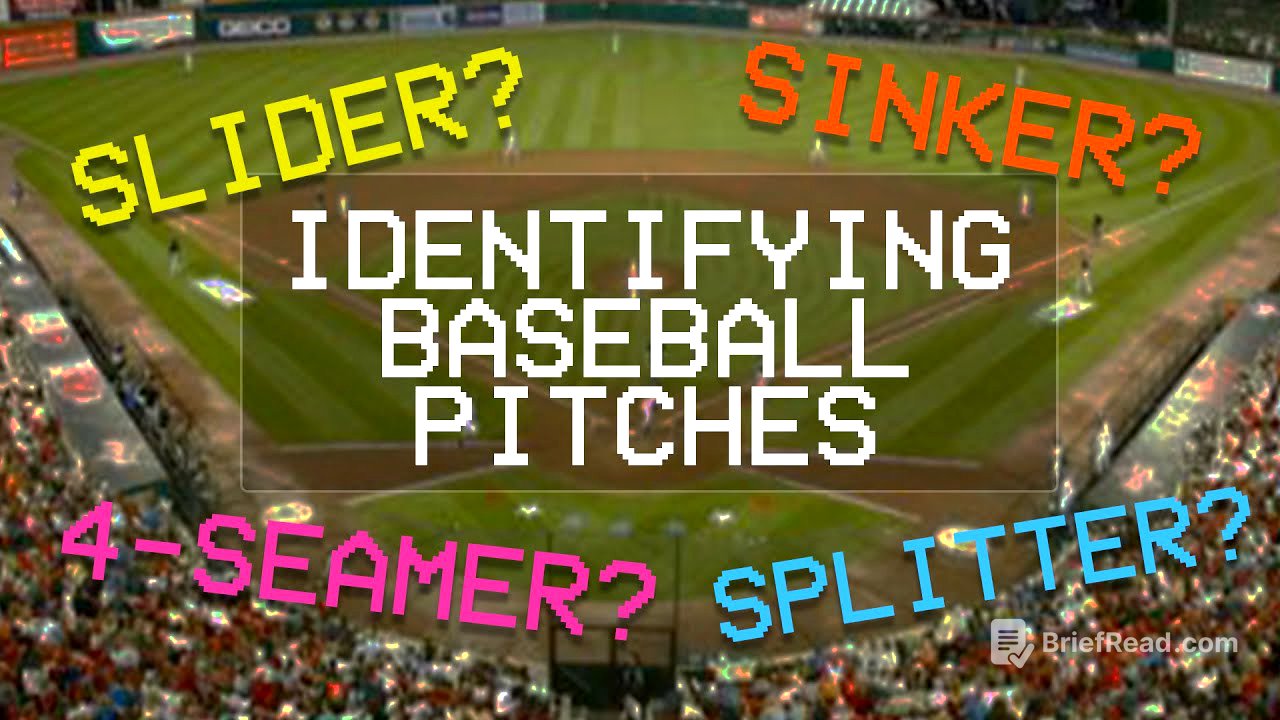TLDR;
This video explains how to identify different types of pitches in Major League Baseball by focusing on velocity, movement, and the pitcher's arsenal. It covers fastballs (four-seam, two-seam/sinker, cutter), breaking balls (curveball, slider), and off-speed pitches (changeup, splitter), as well as less common pitches like the eephus, forkball, screwball, and knuckleball. The video emphasizes that identifying pitches improves with knowledge of a pitcher's tendencies and attention to pitch characteristics displayed on screen.
- Velocity, movement, and pitcher's arsenal are key to identifying pitches.
- Fastballs include four-seam (straight), two-seam/sinker (downward/arm-side movement), and cutter (sharp glove-side movement).
- Breaking balls include curveballs (slow, looping) and sliders (faster, diagonal break).
- Off-speed pitches include changeups (slower fastball mimic) and splitters (fastball-like with late downward break).
Introduction [0:00]
The video introduces the challenge of identifying different types of pitches in Major League Baseball and aims to help viewers recognize them. The three key factors in identifying pitches are velocity, movement, and the individual pitcher's arsenal. Baseball Savant can be used to research the pitches a specific pitcher throws, which helps narrow down the possibilities.
Fastballs [0:45]
Fastballs are the most common pitch in baseball, with three main types. The four-seam fastball is the most frequently used and easiest to identify because it appears to travel in a straight line due to its high backspin. Some four-seam fastballs seem to rise as they approach the plate, though this is an illusion. The two-seam fastball, also known as a sinker, has movement as it nears the plate, typically downward or towards the pitcher's arm side. The term "two-seamer" is used if the pitch is up in the zone or has lateral movement, while "sinker" is reserved for pitches that drop or arrive low in the zone, though the terms are often used interchangeably. The cutter is the least common fastball, characterized by late, sharp movement toward the pitcher's glove side, though it can also drop or break like a slider, making it difficult to identify.
Breaking Balls [3:35]
Breaking balls are thrown with significant top or side spin, causing them to change direction as they approach the plate. The two main types are curveballs and sliders. Curveballs are generally slower, with the classic 12-to-6 curveball breaking downwards, though they can also move towards the pitcher's glove side or drop straight down. Curveballs typically travel between 60 to 80 mph with a looping motion. Sliders break diagonally towards the pitcher's glove hand side and are generally faster with a tighter break than curveballs. Pitches that don't fit neatly into either category are sometimes called "slurves," but all are breaking balls.
Off Speed Pitches [5:05]
Off-speed pitches mimic fastballs but are thrown at a lower velocity. The two common types are changeups and splitters. A changeup is designed to look like a fastball but arrives 8 to 15 mph slower, often resembling a sinker. Identifying changeups becomes easier by paying attention to pitch velocities displayed on screen. The splitter is thrown like a fastball but has a significant and late downward break due to its low spin rate, achieved with a split-finger grip. While it may initially look like a curveball or sinker, its velocity helps distinguish it. Splitters are less common, so knowing a pitcher has one aids in identification.
Less Common Pitches [7:38]
Besides the common pitch types, there are a few less frequently seen pitches. The eephus pitch is an incredibly slow, high-arcing breaking ball. A forkball is like an extreme splitter, often landing in the dirt. A screwball breaks in the opposite direction of a slider, towards the pitcher's arm side, but hasn't been thrown at the major league level in years. Finally, the knuckleball is an unpredictable pitch thrown with almost no spin.
Tips for Identifying Pitches [8:36]
To improve pitch identification, research the starting pitchers' arsenals on Baseball Savant before watching a game. Pay attention to pitch movement and velocity displayed on TV. With practice, identifying pitches will become easier. The video uses well-executed examples where the batter doesn't make contact to clearly show pitch movement. In reality, not every pitch will conform perfectly to its definition, and pitchers vary velocity, movement, and location to keep batters guessing.









